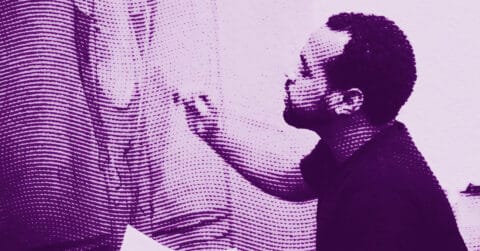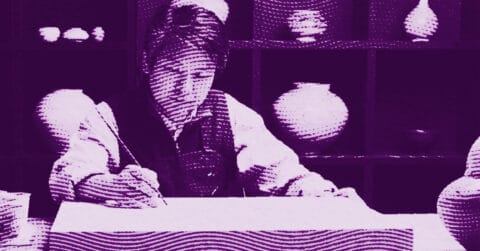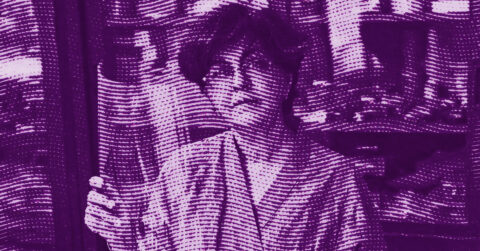Listen to me carefully, you bunch of snobs, it is time to talk about Ayako ROKKAKU (born in 1982 in Chiba, Japan), this artist who is skyrocketing Asian auctions with her fingers full of acrylic paint.
While often every artistic gesture is calculated, every brushstroke theorized to exhaustion by curators in black suits sipping lukewarm champagne, Rokkaku arrives barefoot, hands covered in paint, and throws her visceral vision of creation in the face of the art market. She paints directly with her fingers, without preliminary sketching, as if she wants to tell us: “Your theories about art? I wash my hands of them, with acrylic.”
The first characteristic of her work is this physical, almost primitive approach to painting. She does not use brushes, too bourgeois, perhaps too conventional. No, she plunges her hands directly into the paint, like a child discovering the tactile pleasure of creation. This method recalls the action paintings of Jackson Pollock, except here, no masculine mystification à la Greenberg. Rokkaku transforms the act of painting into a performance where the whole body participates in creation. It’s Yves Klein without the blue, Ana Mendieta without the blood, a form of body art that leaves colorful traces rather than dramatic imprints.
This bodily approach to painting echoes the phenomenological philosophy of Maurice Merleau-Ponty. In “Eye and Mind” (1964), he wrote: “The painter brings her body… It is by lending her body to the world that the painter transforms the world into painting.” Rokkaku literally embodies this idea. Her fingers become direct extensions of her creative consciousness, erasing the traditional distance imposed by the brush between the artist and her work. It is a return to what Walter Benjamin called the tactile experience of art, before mechanical reproduction came to sterilize everything.
The second characteristic of her work lies in her unique visual universe, populated by female figures with oversized eyes and elongated limbs, floating in abstract spaces with vibrant colors. These characters, often described as “kawaii” (cute in Japanese), are actually much more complex. They carry an unsettling strangeness that would have made Freud rejoice. These little girls with sometimes empty, sometimes accusatory gazes are inhabitants of a world where innocence borders existential unease.
Her creations recall what Gaston Bachelard described in “The Poetics of Reverie” (1960) as “cosmic childhood,” the state where boundaries between the real and imaginary dissolve. But unlike traditional imagery of childhood, Rokkaku’s characters are not simply cute or reassuring. They possess a disturbing ambiguity, aligning them more with Hans Bellmer’s unsettling dolls than commercial manga characters.
This duality between apparent naivety and underlying complexity makes Rokkaku a particularly relevant artist in our era of tensions between authenticity and artifice. Her works have become so sought after that her canvases now sell for several hundred thousand euros, making her the sixth highest-valued Japanese artist of all time. Not bad for someone who began by painting on cardboard collected from Tokyo parks.
Commercial success could be seen as a betrayal of the original spontaneity of her approach. But Rokkaku maintains remarkable integrity in her practice. Whether she paints on a seven-meter canvas or a piece of cardboard, she keeps the same direct, physical, almost primitive approach to creation. She continues her live painting performances, transforming the creative act into a public spectacle, demystifying the artistic process while theatricalizing it.
Her recent work has expanded into sculpture, notably in bronze and glass, proving that her magical fingers can shape matter in all its forms. In these three-dimensional works, the same tension between “kawaii” and the unsettling is found, between the spontaneity of gesture and the permanence of material. Her glass sculptures, created in Murano, are particularly fascinating, as if her painted characters suddenly took form in real space, frozen in their momentum by the transformation of molten glass.
Rokkaku’s journey is a masterful slap in the face to all those who think that art nowadays must necessarily be conceptual, distant, and intellectualized. She proves that it is still possible to create visceral, direct, emotionally charged art without falling into ease or complacency. Her growing success, particularly in Asia where her works reach record prices, shows that there is still an audience for art that speaks to the heart as much as to the mind. Rokkaku reminds us that creation can still be an act of pure joy, discovery, and uninhibited exploration. She is living proof that innocence, when carried by a strong artistic vision and undeniable technical mastery, can be a revolutionary force.
Her works remind us of what Paul Klee wrote in his “Theory of Modern Art”: “Art does not reproduce the visible; instead, it makes visible.” Rokkaku makes visible an inner world where joy and worry, innocence and consciousness, spontaneity and control coexist in a precarious and fascinating balance. She invites us to plunge our own hands into the substance of our dreams, to rediscover that creative freedom we all knew as children before the world taught us to stay clean and tidy.
She has become an essential artist on the contemporary scene, exhibiting in prestigious institutions such as the Long Museum in Shanghai and the Kunsthal in Rotterdam. But what is remarkable is that she has managed to maintain the essence of her artistic approach despite commercial success. She continues to paint with her hands, create live performances, push the limits of her art while remaining true to her original vision.
If some critics see in her work a mere extension of Japanese “kawaii” culture, it is because they have not looked closely enough. Her works are traversed by a constant tension between the charming and the unsettling, the spontaneous and the controlled, the childlike and the deeply adult. It is precisely this complexity that makes her art more than just an expression of Japanese pop culture.
Her path is all the more remarkable because she is self-taught. While degrees from prestigious schools often serve as a pass, she has imposed herself by the sheer strength of her vision and practice. She could almost embody what Dubuffet sought in Art Brut: a creation free from all cultural conditioning, even though, paradoxically, her work is deeply rooted in contemporary visual culture.
Rokkaku moves between Berlin, Porto, and Tokyo, creating art that transcends cultural boundaries while remaining deeply personal. She represents a new generation of global artists who draw from their cultural roots while creating a universal visual language. Her growing success is a testament to a thirst for sincerity and authenticity in an intellectual environment often dominated by posturing.
It is fascinating to see how she has managed to turn what could have been just an original technique, finger painting, into a true artistic signature. This tactile approach to painting is a philosophy of creation that places the body and instinct at the center of the artistic process. Rokkaku reminds us that art can still be a direct, visceral, emotionally charged experience. She proves that simplicity is not the enemy of depth, and that spontaneity can coexist with technical mastery.
Her commercial success could be seen as a form of recuperation by the art market, but it also testifies to an authentic thirst for art that speaks directly to emotions, that doesn’t need to be explained by pages and pages of critical theory to be appreciated. In our artistic environment, too often hermetic and elitist, it is a breath of fresh air.
















